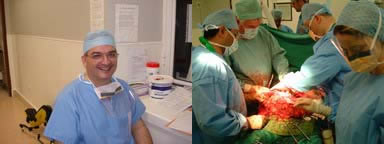 |
 |
|
|
All images, illustrations & flash animation are copyrighted to Deya Marzouk, unless stated otherwise. Copy is prohibited without written permission. Innovative techniques mentioned in this web site were all devised by Deya Marzouk. Please Credit Deya Marzouk if any material is copied from here (with prior permission only) |
Rectovaginal fistula is an abnormal hole in the back wall of the vagina, which allows the contents of the rectum (back passage) to escape through the vagina. It may thus present with
1) Abnormal discharge from the front (this is usually offensive, brownish and may contain frank faeces)
2) Escape of wind from the front passage
3) Bleeding
Rectovaginal fistulae are caused by a variety of conditions. In many cases the cause is not clear. Known causes include trauma (sustained during childbirth, surgery or very rarely during rough sex involving objects), infection, Crohn's disease, after radiation treatment and when cancer of the rectum or vagina invades the other organ.
To start with rectovaginal fistulae (fistulas) needs some form of surgery to heal. There are a variety of surgical techniques that can be used and it is often useful to have these treated by someone with experience in their management, because different situations may call for different surgical approaches. Recurrence is not uncommon and many women would need more than one operation to heal the fistula
It is also essential that initial evaluation check the patient for any specific cause (e.g. Crohn's disease) and this should be treated appropriately. Any specific cause may alter the timing and choice of surgery
Malignant fistulas (caused by cancer), whenever feasible would need removal of both the rectum and at least part of the vagina (en-bloc resection). Fistulas after radiation treatment often require complex surgical procedures involving removal of the rectum and joining the bowels to the top of the anus (colo-anal anastomosis). Fistulas secondary to Crohn's disease may .
There are no hard and fast rules here. Patients often do not like the idea, however, these fistulas do not heal easily in many patients and I do favour adding a diverting colostomy to protect repairs.
A diverting colostomy is really essential in case of recurrent fistulas, presence of sepsis, Crohn's disease and associated anal sphincter injury
Not a lot! Repeat cleansing of the vagina with warm water and constipating medications (such as Imodium) may help reduce discharge in patients with loose motions. These measures may be used under the following circumstances:
There are 4 main approaches to repair rectovaginal fistulas (with or without supplementary procedures such as gracilis muscle interposition). Rectovaginal fistula may be repaired through the anus (transanal), through the vagina (transvaginal), through the perineum (Perineal proctotomy, York-Mason) and abdominally.
I will write this section & include operative photos soon.
Once healed, the only precaution needed is to avoid trauma to the new repair, by avoiding sexual intercourse for few months
 |
 |
|